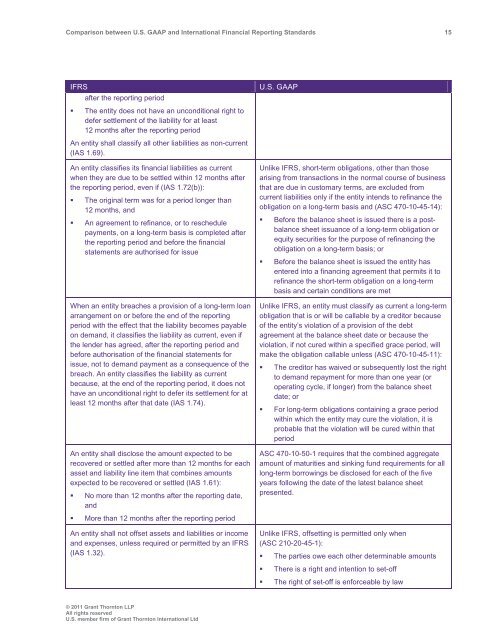Comparison between U.S. GAAP and International ... - Grant Thornton
Comparison between U.S. GAAP and International ... - Grant Thornton
Comparison between U.S. GAAP and International ... - Grant Thornton
You also want an ePaper? Increase the reach of your titles
YUMPU automatically turns print PDFs into web optimized ePapers that Google loves.
<strong>Comparison</strong> <strong>between</strong> U.S. <strong>GAAP</strong> <strong>and</strong> <strong>International</strong> Financial Reporting St<strong>and</strong>ards 15<br />
IFRS<br />
after the reporting period<br />
• The entity does not have an unconditional right to<br />
defer settlement of the liability for at least<br />
12 months after the reporting period<br />
An entity shall classify all other liabilities as non-current<br />
(IAS 1.69).<br />
An entity classifies its financial liabilities as current<br />
when they are due to be settled within 12 months after<br />
the reporting period, even if (IAS 1.72(b)):<br />
• The original term was for a period longer than<br />
12 months, <strong>and</strong><br />
• An agreement to refinance, or to reschedule<br />
payments, on a long-term basis is completed after<br />
the reporting period <strong>and</strong> before the financial<br />
statements are authorised for issue<br />
When an entity breaches a provision of a long-term loan<br />
arrangement on or before the end of the reporting<br />
period with the effect that the liability becomes payable<br />
on dem<strong>and</strong>, it classifies the liability as current, even if<br />
the lender has agreed, after the reporting period <strong>and</strong><br />
before authorisation of the financial statements for<br />
issue, not to dem<strong>and</strong> payment as a consequence of the<br />
breach. An entity classifies the liability as current<br />
because, at the end of the reporting period, it does not<br />
have an unconditional right to defer its settlement for at<br />
least 12 months after that date (IAS 1.74).<br />
An entity shall disclose the amount expected to be<br />
recovered or settled after more than 12 months for each<br />
asset <strong>and</strong> liability line item that combines amounts<br />
expected to be recovered or settled (IAS 1.61):<br />
• No more than 12 months after the reporting date,<br />
<strong>and</strong><br />
• More than 12 months after the reporting period<br />
An entity shall not offset assets <strong>and</strong> liabilities or income<br />
<strong>and</strong> expenses, unless required or permitted by an IFRS<br />
(IAS 1.32).<br />
U.S. <strong>GAAP</strong><br />
Unlike IFRS, short-term obligations, other than those<br />
arising from transactions in the normal course of business<br />
that are due in customary terms, are excluded from<br />
current liabilities only if the entity intends to refinance the<br />
obligation on a long-term basis <strong>and</strong> (ASC 470-10-45-14):<br />
• Before the balance sheet is issued there is a postbalance<br />
sheet issuance of a long-term obligation or<br />
equity securities for the purpose of refinancing the<br />
obligation on a long-term basis; or<br />
• Before the balance sheet is issued the entity has<br />
entered into a financing agreement that permits it to<br />
refinance the short-term obligation on a long-term<br />
basis <strong>and</strong> certain conditions are met<br />
Unlike IFRS, an entity must classify as current a long-term<br />
obligation that is or will be callable by a creditor because<br />
of the entity’s violation of a provision of the debt<br />
agreement at the balance sheet date or because the<br />
violation, if not cured within a specified grace period, will<br />
make the obligation callable unless (ASC 470-10-45-11):<br />
• The creditor has waived or subsequently lost the right<br />
to dem<strong>and</strong> repayment for more than one year (or<br />
operating cycle, if longer) from the balance sheet<br />
date; or<br />
• For long-term obligations containing a grace period<br />
within which the entity may cure the violation, it is<br />
probable that the violation will be cured within that<br />
period<br />
ASC 470-10-50-1 requires that the combined aggregate<br />
amount of maturities <strong>and</strong> sinking fund requirements for all<br />
long-term borrowings be disclosed for each of the five<br />
years following the date of the latest balance sheet<br />
presented.<br />
Unlike IFRS, offsetting is permitted only when<br />
(ASC 210-20-45-1):<br />
• The parties owe each other determinable amounts<br />
• There is a right <strong>and</strong> intention to set-off<br />
• The right of set-off is enforceable by law<br />
© 2011 <strong>Grant</strong> <strong>Thornton</strong> LLP<br />
All rights reserved<br />
U.S. member firm of <strong>Grant</strong> <strong>Thornton</strong> <strong>International</strong> Ltd
















